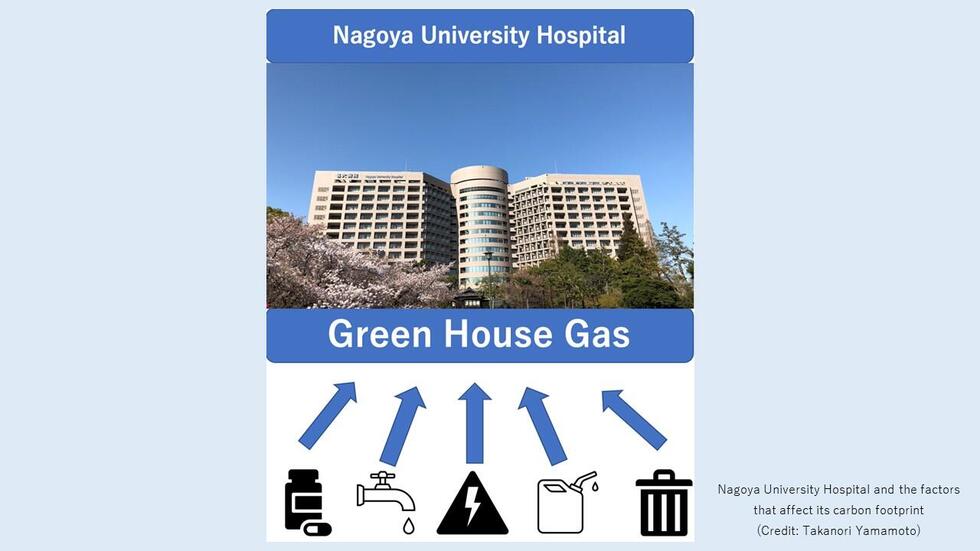
Medicine, Dentistry, and Pharmacy
December 20, 2022
Increased use of pharmaceuticals increased carbon emissions during the COVID-19 pandemic despite carbon footprint reduction efforts
A group of researchers measuring carbon emissions in a large university hospital with a research center in central Japan found that its overall carbon footprint increased over a decade. However, they also found that carbon emissions from gas and electricity decreased during the COVID-19 pandemic. They published their findings in the journal Globalization and Health.
If action is to be taken on the climate crisis, it is urgent to evaluate carbon emissions in the medical sector. The medical industry in developed countries is responsible for a large proportion of their carbon footprint. For example, healthcare in the United States contributes approximately 10% to its national carbon footprint. As a result, the medical sector is trying to reduce emissions such as in the United Kingdom, where the National Health Service seeks to become carbon neutral by 2045.
Japan is also seeking to reduce its carbon footprint. It was the sixth largest emitter of greenhouse gases in 2019, making it a major contributor to global carbon emissions. Currently, the national government is seeking, by 2030, to reduce greenhouse gas emissions by 26% from 2013 levels. The next step is to become carbon neutral by 2050.
During the past three years, one factor that may also have affected the carbon emissions produced by the medical sector is the COVID-19 pandemic. Therefore, it is essential to not only monitor long-term trends in industry carbon emissions, but also to determine the impact of shocks caused by outbreaks of infectious diseases.
To evaluate changes over time in the carbon footprint of a large Japanese medical institution, a research group led by lecturer Takanori Yamamoto, clinical fellow Hikaru Morooka, and Professor Shoichi Maruyama of Nagoya University Graduate School of Medicine, recorded the electricity, gas, water usage, pharmaceutical and medical supply costs, and waste amounts of the Nagoya University Hospital and Nagoya University Graduate School of Medicine from 2010 to 2021. Located in the city of Nagoya, Nagoya University Hospital is one of the largest hospitals in Japan, employing over 2000 staff members and serving more than half a million patients each year.
The research team found that the overall carbon footprint in 2020 had increased almost 27% over 10 years. Approximately one-quarter of these carbon emissions came from electricity consumption. Although carbon emissions resulting from electricity and gas decreased over the study period, the overall carbon footprint of the hospital still increased. Since Nagoya University Hospital uses advanced medical care, this increase in carbon emissions could be related to the increased use of pharmaceuticals and medical supplies necessary for treating patients, many of them elderly.
Despite an overall increase in the hospital’s carbon footprint during the study, it decreased slightly, by just over 2%, in the first year of the COVID-19 pandemic. This was in part due to the lower number of patients in 2020 and the resulting reductions in pharmaceuticals, water usage, and nonmedical waste.
However, despite a decrease in the hospital’s overall carbon footprint, the severity of COVID-19 still contributed to carbon emissions. During the pandemic, the average hospital stay of a patient was longer due to the need for greater medical care. Furthermore, the higher number of patients requiring intensive care meant an increase in carbon emissions from pharmaceuticals. As a result, although there was a decrease in the overall carbon footprint between 2018 and 2020, the monthly carbon footprint per hospital admission increased. In other words, the overall size of the hospital’s carbon footprint was smaller than in previous years because of fewer patients, but the severity of COVID-19 meant that the carbon footprint per hospitalization was higher. The good news is that during periods when the risk of severe illness is low and patients do not require hospitalization and intensive care, hospitals may be able to reduce the use of pharmaceuticals that produce carbon emissions.
Another factor contributing to the increase in the hospital’s carbon emissions may be Nagoya’s hot summers. As the outside temperature in the city rose, so did Nagoya University Hospital’s carbon footprint. The likely cause was an increase in electrical and gas consumption to maintain a comfortable indoor temperature for staff and patients. Therefore, with the increasing heat associated with climate change, the carbon footprint of medical institutions is likely to grow.
“There are two important lessons from this research. First, it is urgent to assess the reality of medical carbon emissions because medical staff cannot sacrifice future generations using the excuse of saving present patients,” says Yamamoto. “Second, it is important to promote public health measures to reduce future medical demands, because the world is facing an aging society, overtreatment, overdiagnosis and unnecessary visits to hospital. It is crucial to recognize the importance of vaccination and preventive medicine from a sustainable perspective. This research shows both the importance and reality of accurately measuring and evaluating carbon emissions at medical facilities around the world.”
The paper, "Influence of COVID-19 on the 10-year carbon footprint of the Nagoya University Hospital and medical research centre," was published in the journal Globalization and Health on November 7, 2022 at DOI: 10.1186/s12992-022-00883-9
Authors:
Hikaru Morooka, Takanori Yamamoto, Akihito Tanaka, Kazuhiro Furuhashi, Yasuhiro Miyagawa ,and Shoichi Maruyama
Media Contact:
Matthew Coslett
International Communications Office, Nagoya University
kouho-en@adm.nagoya-u.ac.jp